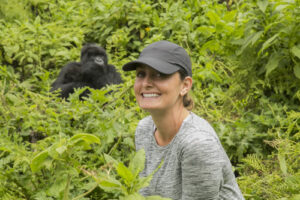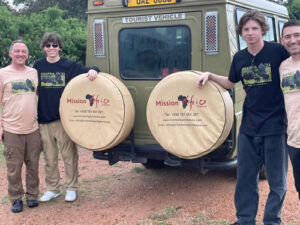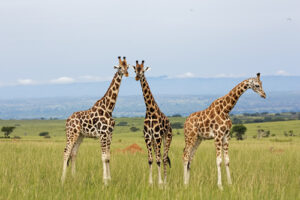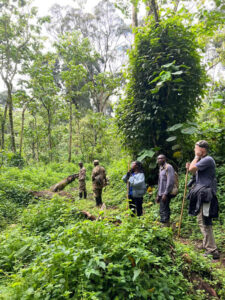Which is the best time to travel to Uganda? Uganda is arguably one of the most sought after tourist destinations in Africa. Located in East Africa, Uganda lies along the equator which gives it a warm sub-tropical climate. As a country, Uganda is famous for lots of beautiful tourism sites like mountains,  Tropical rain-forests, lakes, rivers and much more. One can be sure to enjoy activities like boats rides in the Lake Victoria, visiting the source of the river Nile in Jinja city, bungee jumping, white water rafting, Zip lining and game.
Tropical rain-forests, lakes, rivers and much more. One can be sure to enjoy activities like boats rides in the Lake Victoria, visiting the source of the river Nile in Jinja city, bungee jumping, white water rafting, Zip lining and game.
There is of course gorilla and chimpanzee trekking. It is because of these amazing Uganda activities and beautiful scenery that Winston Churchill described Uganda as the Pearl of Africa. Some of these activities are best during certain weather seasons while others are not. Boat rides may not open to the public during the rainy season as it may not be safe. Before we discuss in detail about the different travel season, you might want to check out a similar article about the best time to visit Africa.
Best Time to Visit Uganda – Dry Season
Uganda has two known seasons which are the rainy season and the dry season. The interesting bit about both of these seasons is that the temperatures do not change much. They are often within the range of 24 to 30 degree Celsius making it conducive to visit Uganda all year round. It should be noted that the weather patterns of Uganda are mainly controlled by the equator that crosses the country. In addition to that, other factors like the dense Tropical rain forests, numerous lakes and rivers have also contributed to the weather patterns. The result is that Uganda receives an average of 1000ml to 2000ml of rainfall annually.
Which is the best time to visit Uganda? The best time of the year to visit Uganda will depend on what one is planning to do in the country. It can be in any of the months of the year although most people prefer to visit during the dry seasons. There are actually two dry seasons which are the months of June to August. These dry months are still characterized by some occasional rains. The months of December to February are the hottest with almost no rain at all. These dry seasons are considered to be the peak seasons as they register the highest number of tourists coming into the country. The dry seasons are the best seasons to go for gorilla and chimpanzee treks because the trek trails are usually dry, mud free and not slippery.
 During the dry seasons, the skies are very clear with great visibility which makes it easier to view wild life and take clear photographs. The dry season is also the best time for spotting game because most animals tend to gather around water holes to drink and cool themselves. During the dry seasons, the roads are often in good condition, making the game parks and game reserves easily accessible. The opposite is true for the rainy season. The month of June is one of the best months to visit Uganda and this is usually the beginning of the peak season. You are therefore advised to book your gorilla trekking permits at least 6 months earlier to save you the disappointments. Gorilla Permits are usually on very high demand during the peak seasons.
During the dry seasons, the skies are very clear with great visibility which makes it easier to view wild life and take clear photographs. The dry season is also the best time for spotting game because most animals tend to gather around water holes to drink and cool themselves. During the dry seasons, the roads are often in good condition, making the game parks and game reserves easily accessible. The opposite is true for the rainy season. The month of June is one of the best months to visit Uganda and this is usually the beginning of the peak season. You are therefore advised to book your gorilla trekking permits at least 6 months earlier to save you the disappointments. Gorilla Permits are usually on very high demand during the peak seasons.
 Tourists who plan to go on a Uganda safari with their children can always choose to do so during the months of June to August. This is because the weather despite being dry, is not as hot as the months of December to February. It has also been observed that the rates of tropical diseases like malaria are very low due to the reduction of mosquitoes and other disease carrying bugs. It should be noted that Uganda is within the tropics and as a result, some rains can still be expected during the dry seasons especially around the country’s mountainous areas like the Mount Elgon in the east, Mount Rwenzori in the west and around dense tropical rain-forests like the Bwindi impenetrable forest, Mabira forest and the others. Tourists are therefore advised to always carry along their rain jackets, water proof boots and other necessary items since the weather can be very unpredictable. Areas around Lake Victoria also experience rainfall even during the dry season because of the high evaporation rates.
Tourists who plan to go on a Uganda safari with their children can always choose to do so during the months of June to August. This is because the weather despite being dry, is not as hot as the months of December to February. It has also been observed that the rates of tropical diseases like malaria are very low due to the reduction of mosquitoes and other disease carrying bugs. It should be noted that Uganda is within the tropics and as a result, some rains can still be expected during the dry seasons especially around the country’s mountainous areas like the Mount Elgon in the east, Mount Rwenzori in the west and around dense tropical rain-forests like the Bwindi impenetrable forest, Mabira forest and the others. Tourists are therefore advised to always carry along their rain jackets, water proof boots and other necessary items since the weather can be very unpredictable. Areas around Lake Victoria also experience rainfall even during the dry season because of the high evaporation rates.
 It’s is also very important to note that in Uganda, temperatures vary according to the altitude of given locations. For example, areas of and around highlands often experience low temperatures all year round with nights being even colder. On the contrary, areas within the low lands and plains such as the kidepo valley national park in the north east experiences very dry conditions. Kidepo valley national park season pattern is quite different from all the other places in Uganda as it has one long dry season that runs from the month of July to February with one wet season that runs from March to June.
It’s is also very important to note that in Uganda, temperatures vary according to the altitude of given locations. For example, areas of and around highlands often experience low temperatures all year round with nights being even colder. On the contrary, areas within the low lands and plains such as the kidepo valley national park in the north east experiences very dry conditions. Kidepo valley national park season pattern is quite different from all the other places in Uganda as it has one long dry season that runs from the month of July to February with one wet season that runs from March to June.
Best Time for a Safari in Uganda – Rainy Seasons
The first rainy season occurs during the months of March to May with April being the wettest of them all. The second wet season runs from September to October. The wet seasons are often characterized by lush green and dense vegetation. During this season, most of the animals in the wild give birth to their  young since there is always plenty of food for them. During the rainy season, one gets the rare opportunity to view thousands of rare species of migratory birds. These birds usually return on noticing a weather change. Visiting Uganda during the non-peak seasons also means that you shall be saving big on some costs. Gorilla trekking permits may be discounted. The prices of accommodation facilities tend to be discounted during this season due to low demand. During the wet seasons, it’s easier to access the primates as one doesn’t have to trek for long to find them. This is because during wet seasons, the primates tend to move and settle on the lower slopes that are warmer. They also have plenty to eat and find no need to move about or migrate.
young since there is always plenty of food for them. During the rainy season, one gets the rare opportunity to view thousands of rare species of migratory birds. These birds usually return on noticing a weather change. Visiting Uganda during the non-peak seasons also means that you shall be saving big on some costs. Gorilla trekking permits may be discounted. The prices of accommodation facilities tend to be discounted during this season due to low demand. During the wet seasons, it’s easier to access the primates as one doesn’t have to trek for long to find them. This is because during wet seasons, the primates tend to move and settle on the lower slopes that are warmer. They also have plenty to eat and find no need to move about or migrate.
In conclusion, Uganda is blessed with conducive weather patterns that allows for tourists to visit the country during any of the months throughout the year since the temperatures do not change much. The best time to travel would be 2 weeks after the rains have stopped. This is the best time to experience the natural beauty in the country because everywhere is green and there is so much life.

